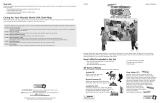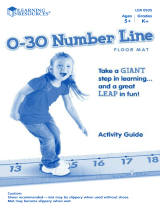Page is loading ...

Teacher's Guide
Grades K and up
EI-1070
The Number Balance provides a hands-on way for students to compare numbers,
practice basic addition facts, discover number properties, and explore pre-algebra
skills. Your Number Balance can be used with the whole class, small groups, or
individual students. It also makes a motivating addition to math center activities.
Assembling the Number Balance
1. Take the items out of the box.
2. Set the base on a flat surface.
3. Insert the red post into the base.
4. Place the "number line" into the post.
5. Insert the black pin through the post and number line.
6. Place the white cap over the black pin to lock into place.
7. Place the white plastic calibration guides along the bottom of the number line.
8. Move the calibration guides until the unit balances.
9. Place the weights on the base pegs for easy access.
Note: The Number Balance is not a scale and equivalent weights hung from unequal numbers or
number combinations will not balance it.
Number Balance Activities
Comparing Numbers
Have students use the Number Balance to explore number relationships. Hang a
weight from any number on one side of the balance. Hang another weight from any
of the numbers on the other side of the balance. For example, hang a weight from
the number 6 on the left side of the balance and from the number 4 on the right side
of the balance. Question students about the results. Which side is higher? Which
side is lower? Why is the side with the number 6 lower than the side with the
number 4? What comparison statements can be made about the two numbers? If
students have learned the symbols for greater than, less than, and not equal to, write
their statements on the chalkboard, for example: 6 > 4; 4 < 6; 6 4. Tell students that
these are mathematical sentences, and ask them to read them back to you. If you
wish, reinforce the abstract concept with counters, such as paper clips. Have students
place six counters under the weight hanging from the number 6 and four counters
under the weight hanging from the number 4.
Addition Facts
Practice basic addition facts with the Number Balance. Have a student hang weights
from any two numbers on the left side of the balance. Then have the student place a
weight on what he thinks the sum of the two addends is. If the student is correct,
the unit will balance. If the student is incorrect, it will not, and the student can try
again.
Try these variations:
g
Have students work in pairs. One student holds up a flash card. The other student
sets up the equation on the balance and solves it. Then the students compare
answers.
g
Have students work in small groups. One student throws a pair of dice. Another
student sets up an equation on the balance that expresses the addition of the two
numbers shown on the dice. A third student solves the equation. Encourage
students to take turns at the different tasks.
Comparing Equations
Demonstrate the relationship between equations using the Number Balance. For
example, hang weights from the numbers 6 and 3 on the left side. Have students
hang weights from two other numbers on the right side, for example 5 and 2. What
happens? Have students express the result as an equation, for example: 6 + 3 5 + 2;
6 + 3 > 5 + 2; 5 + 2 < 6 +3. Remove the numbers from the right side of the balance.
Challenge students to hang weights from two numbers that will balance the scale,
for example: 4 and 5. As they balance the scale, ask them what comparison
statements can be made about 6 + 3 and 4 + 5. Write down their answers, for
example, "They’re the same," "They’re equal," 6 + 3 = 4 + 5. Challenge students to
come up with as many equations that are equivalent to 6 + 3 as possible.
As students become more experienced, have them experiment with two numbers on
one side and three on the other, for example: 8, 5, and 3 on the left side and 6 and
10 on the right. Have them write equations that show the relationships.
Commutative Property
Help students understand the concept that order does not affect the sum of an
addition equation. Have a student hang weights from any two numbers on the left
side. Have him write down the order in which he placed the numbers as an
expression, for example 8 + 4. Have another student hang the same numbers, but in
the opposite order, on the right side and write the expression, for example, 4 + 8.
Question students about the results. Is there any difference between 8 + 4 and 4 + 8?
Did the order in which the weights were hung affect the balance? Encourage
students to repeat the experiment with three numbers.
Pre-Algebra
Hang a weight on one side of the balance. Place another weight on a different
number on the other side of the balance. For example, place a 5 on the left and a 9
on the right. Write the equation 5 + = 9. Challenge students to find the number on
the left that will help balance the unit.
Reverse the operation: hang a 9 on the left and a 5 on the right. Write the equation
9 - = 5. Challenge students to find the number on the right that will balance the
unit. Ask them how they were able to discover that the number 4 balanced the unit.
Discuss the relationship between addition and subtraction. Lead them to understand
that addition and subtraction are inverse operations and missing variables can be
found by doing the opposite operation.
© Copyright 2001 Educational Insights, Inc.
2206 Oakland Parkway, Columbia, TN 38401
All rights reserved. Conforms to: ASTM F-963; EN-71
Please retain this information.
www.educationalinsights.com
Customer Service (800) 995-4436
Made in Taiwan
/



